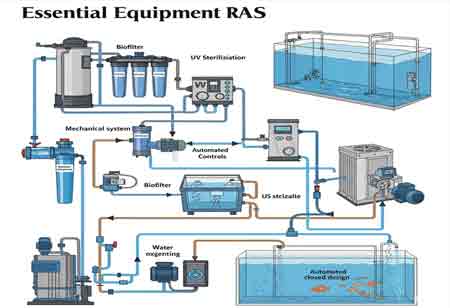Thank you for Subscribing to Agri Business Review Weekly Brief
RAS Technology and the Future of APAC Aquaculture
The Asia-Pacific region is adopting Recirculating Aquaculture Systems (RAS) for sustainable seafood production, minimizing water use and environmental impact.

By
Agri Business Review | Friday, July 04, 2025
Stay ahead of the industry with exclusive feature stories on the top companies, expert insights and the latest news delivered straight to your inbox. Subscribe today.
Fremont, CA: The Asia-Pacific (APAC) region, with its burgeoning population and increasing demand for seafood, is at the forefront of adopting innovative aquaculture technologies. Among these, Recirculating Aquaculture Systems (RAS) are gaining significant traction, offering a sustainable and efficient alternative to traditional open-pond farming. These closed-loop systems minimize water usage, reduce environmental impact, and provide precise control over the aquatic environment, leading to healthier fish and higher yields.
Key Equipment Essentials in a RAS
A RAS is an integrated setup comprising fish tanks, filtration units, degassers, oxygenation systems, and efficient pumps to maintain a stable and productive aquatic environment. Fish culture tanks are designed to optimize fish welfare by promoting growth and minimizing stress. Mechanical filtration removes uneaten feed and fecal matter, while biological filtration facilitates the nitrogen cycle by converting harmful ammonia into nitrite and nitrate through the action of nitrifying bacteria. Degassing units remove dissolved gases and excess nitrogen, while oxygenation systems replenish dissolved oxygen consumed by fish and beneficial microbes. UV sterilization and ozone systems are employed for water disinfection to safeguard fish health. Efficient pumps and plumbing networks ensure continuous water circulation, while automated water quality monitoring and control systems enhance operational efficiency and ensure optimal water quality. Automated feeders deliver nutrients to the stock, reducing labor requirements and feed waste, promoting cleaner operations and better growth performance, thereby contributing to a sense of satisfaction and accomplishment among aquaculture professionals.
Benefits of RAS in the APAC Region
Chief among these is water conservation, as RAS can reduce water usage by up to 90–99 percent compared to traditional aquaculture methods, making it a viable solution in water-scarce areas. From an environmental standpoint, RAS minimizes effluent discharge, thereby protecting natural waterways and mitigating the risk of disease transmission to wild fish populations. The system also enables location flexibility, allowing aquaculture operations to be established in urban settings or regions far from natural water sources. This not only reduces transportation costs but also enhances proximity to local markets.
RAS provides a biosecure and controlled environment that significantly lowers the risk of disease outbreaks and reduces reliance on antibiotics. Its capacity for climate-independent operation supports year-round production and multiple harvest cycles, leading to a more consistent and reliable supply. The efficient water treatment inherent in RAS further permits higher stocking densities, maximizing yield per unit area. RAS supports species diversification, accommodating the cultivation of a wide range of aquatic species, including high-value finfish such as barramund and tilapia, as well as various marine species, thereby expanding market opportunities for producers in the region.
Ongoing advancements in automation, energy efficiency (e.g., integration with renewable energy sources), and system design are continually addressing these challenges. Governments and private entities in APAC are increasingly investing in research, development, and training programs to promote RAS adoption. The integration of RAS with other sustainable technologies, such as aquaponics, is also gaining traction, offering diversified product portfolios and enhanced resource utilization.
RAS represents a paradigm shift in aquaculture, offering a sustainable, controlled, and highly productive approach to fish farming. For the APAC region, with its growing demand for seafood and increasing environmental consciousness, RAS is not just an alternative but a crucial pathway towards a more resilient and responsible aquaculture industry. By understanding and investing in essential equipment and embracing technological advancements, the APAC region can lead the way in closed-loop farming, ensuring a sustainable future for seafood production for generations to come.





